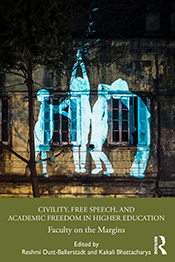- About
- Programs
- Issues
- Academic Freedom
- Political Attacks on Higher Education
- Resources on Collective Bargaining
- Shared Governance
- Campus Protests
- Faculty Compensation
- Racial Justice
- Diversity in Higher Ed
- Financial Crisis
- Privatization and OPMs
- Contingent Faculty Positions
- Tenure
- Workplace Issues
- Gender and Sexuality in Higher Ed
- Targeted Harassment
- Intellectual Property & Copyright
- Civility
- The Family and Medical Leave Act
- Pregnancy in the Academy
- Publications
- Data
- News
- Membership
- Chapters
Academic Freedom, Incivility, and Resistance
 Civility, Free Speech, and Academic Freedom in Higher Education: Faculty on the Margins, ed. Reshmi Dutt-Ballerstadt and Kakali Bhattacharya. New York and London: Routledge, 2021.
Civility, Free Speech, and Academic Freedom in Higher Education: Faculty on the Margins, ed. Reshmi Dutt-Ballerstadt and Kakali Bhattacharya. New York and London: Routledge, 2021.
Reshmi Dutt-Ballerstadt and Kakali Bhattacharya have edited a collection of thoughtful and powerful essays about how American colleges and universities use civility codes to police and repress faculty members of color who speak up against their institutions and white supremacy. The editors are well-known for their work on diversity, decolonial praxis, and approaches grounded in critical race theory and feminism. As scholar-activists, they have experienced microaggressions and challenges to their scholarly, pedagogical, and activist work. In other words, this book emerges from their experiences and from their firm commitment to supporting faculty of color who are marginalized in academia. They fittingly “dedicate this collection to incivility as a mode of resistance that continues to rupture status quo and power structures.”
The book is divided into three sections. Part 1, “Black Bodies: Weaponizing the Personal,” contains three essays. Shannon Gibney describes her painful experience of returning to work after the death of her infant only to be challenged by white male students for teaching about structural racism in a mass communication class. She details the classroom environment as well as the response from an administration that found her, a Black woman, in violation of her college’s nondiscrimination policy for having allegedly created a hostile environment for white men. (Readers who find this summary too absurd to be believed might skip ahead to Kakali Bhattacharya’s essay on civility as absurdity, described below.) In the second essay, Saida Grundy writes about the attacks she faced as a new professor at Boston University. While in graduate school, Grundy had commented on Twitter about structural racism in the academy from her perspective as a Black feminist sociologist. After her appointment at BU, these tweets became fodder for an online campaign targeting her and urging the university to revoke its job offer. Using her experience as a starting point, she examines the “whiteness” of such attacks on Black academics, arguing that they have a “generative effect”: “they create vast groups that are closely formed around a collective White identity that is solidified by anti-Black racism.” Finally, Taiyon J. Coleman writes of an incident on her campus in Minnesota, where a white security guard fabricated a report about having been shot by an unknown Black man. This false charge created anxiety and fear on the campus and in the neighboring community. As Coleman watched students and colleagues express their fear during community events focused on the incident, she recognized her unusual situation as one of the few Black women on campus who was in attendance. She compares the situation to an art exhibit by Ken Gonzales-Day on lynchings in the 1920s, writing that “I didn’t know if I was the spectator or the one being lynched in that moment.” Her reflections led her to see that she had been empathizing with the fears of her predominantly white students and colleagues, having been desensitized to the experiences of Black and brown bodies, especially male bodies. Her essay offers deep insights into how misreadings and misrepresentations of such incidents perpetuate the power of the dominant culture.
Part 2, “Civility, Repression, and Academic Freedom: Bodies on the Line,” includes contributions from four scholars. Mohan J. Dutta describes the culture of surveillance in higher education in which, he argues, new technologies constantly monitor academics and gather data about them in the service of building a “colonial capitalist university” that uses transnational rankings and reputation to increase its profits. Dutta weaves in his own experiences fighting his institution, which has sought to curtail his scholarly work on new media because of its disruption of this system. Arianne Shahvisi’s essay, meanwhile, provides a conceptual analysis of civility and how it is employed in academia to show that civility is ambiguous, and the ambiguity is often used to constrain academic freedom. She contends that universities cultivate an air of mystique around knowledge and expertise through their architecture, rituals, and culture and that academics have an “epistemic privilege” that extends beyond their fields of expertise. Writing that “academic freedom . . . consists of the right to engage in research, teaching, and public debate without restriction, provided that one’s speech is sensitive to the way in which epistemic privilege amplifies any potential harm,” she argues that academics can reclaim their “epistemic privilege” to achieve epistemic justice. In the following essay, Dana L. Cloud usefully discusses how the call for civility is a form of soft repression that is “not explicitly violent, punitive, or coercive, but disciplining nonetheless.” Reshmi Dutt-Ballerstadt concludes the section with a discussion of the discrimination and intimidation she experienced on her campus because of her stance against right-wing speakers like Jordan Peterson. She tackles the problems inherent in the “viewpoint diversity” championed by her white colleagues.
Part 3, “Politics of Permissibility and Absurdity: Narratives of Civility,” includes three essays. Matthew Abraham offers a deep analysis of Steven Salaita’s tweets, which infamously led the University of Illinois at Urbana-Champaign to rescind his job offer, and discusses how forces outside academia use civility to repress dissident and transformative scholarship. Jeong-eun Rhee and Mary Pigliacelli, in “The ‘F’ Bomb and the ‘R’ Word,” use creative writing to capture how rank, race, gender, and disciplinary expertise influence academics’ responses to the free-speech grenades lobbed at them. The authors’ inventive approach, along with the theoretical questions they open for discussion, offers a rich space to think through how individuals experience the tension between academic freedom and civility. In the following essay, Manali J. Sheth and Natasha N. Croom use collaborative autoethnography to argue that “retaliation, epistemic violence, and unequal distribution of resources” disproportionately affect women of color doing intersectional work. Kakali Bhattacharya’s “Civility as Absurdity, Absurdity as Civility in Higher Education,” drawn from a conference presentation at UIUC (the very institution that had denied Salaita a job), dramatizes how everyday interactions occur between a woman of color administrator, a white faculty member, and a faculty member of color. The dialogue highlights the illogicality of such exchanges and points to the deeply existential problem for people of color in the academy.
The book concludes with an afterword by Johnny E. Williams, who usefully unpacks the discourse of civility. For any reader who is unfamiliar with the academic freedom issues underlying this discourse, the afterword is a good place to start before diving into the rest of the rich essays.
Dutt-Ballerstadt and Bhattacharya’s book is one that all faculty members of color should read at the start of their careers. Every fall, as the new academic year begins, universities orient their new faculty. For many faculty members of color, experiences of marginalization begin with these orientations. Books like this one, along with Sarah Ahmed’s work and the two volumes of Presumed Incompetent, should be in the library of every faculty member of color. The essays in this book are honest and often relate deeply painful experiences. They are also rigorous in their analysis of academia, offering us an opportunity to reflect on our experiences. The move away from the standard academic essay in part 3 to include creative writing and autoethnography is particularly thought-provoking.
Nalini Iyer is a professor of English at Seattle University, where she specializes in postcolonial and feminist studies. She is also chief editor for South Asian Review. Her email address is [email protected]




